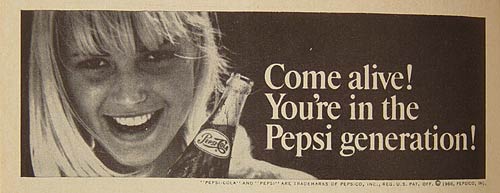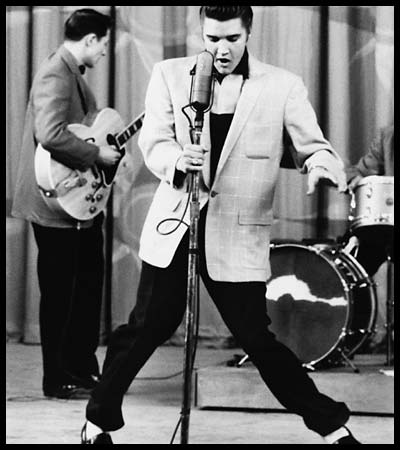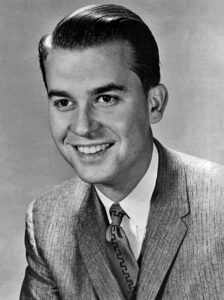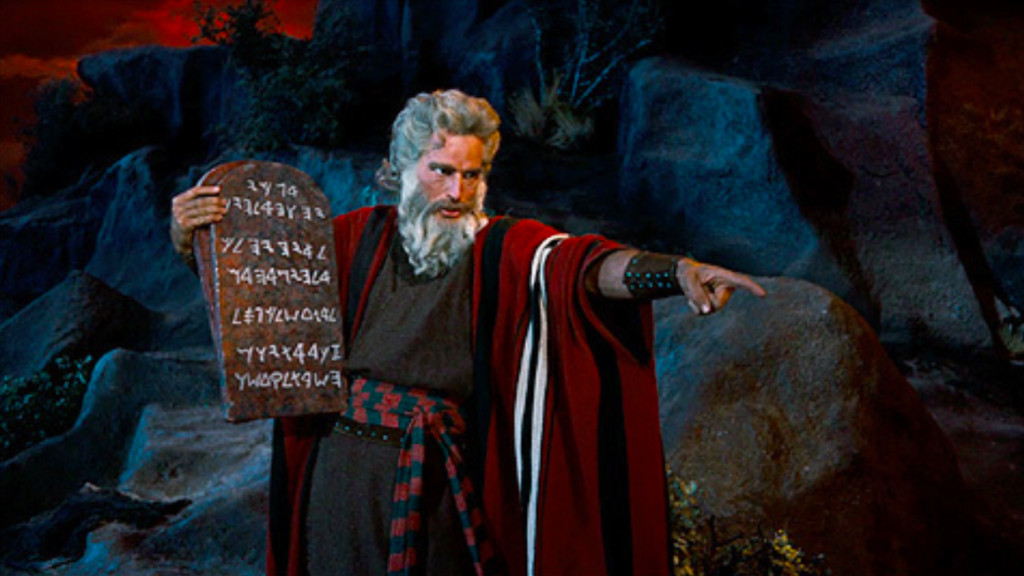
Please pay no attention to the sexy blonde girl pointing a phallic symbol at suggestive wordplay because this post is actually about “Generation Gaps.” Of course, since most of us have ingested Pepsi products, we are now perpetual members of THAT generation. But did you know that the sociological theory of a generational “gap” first came to light in the 1960s, and sociologists now refer to it as “institutional age segregation?”
Allow me to write that again; Institutional Age Segregation. For me, that reads like an in-your-face revelation of the method by the so-called controllers of society. We are engaged in spiritual warfare, folks, and this is our enemy mocking us. Of course, a healthy amount of rebellion and individuality is natural. But there appears to be little doubt that this propagation of generational division that began in the 1950s (MKUltra) was intentional and that it has been instrumental in undermining society by creating distrust and antagonism where there should be mutual respect and admiration.
Up to this point, I have highlighted two propaganda films created by military personnel (Blackboard Jungle & Rebel Without a Cause) about teen angst and rebellion, but which came first? Was media merely reflecting or actively promoting these antagonistic attitudes? Considering that many teens of that era had a reasonably uncomplicated lifestyle, I find the latter possibility much more likely. Since I wasn’t a teen in the ’50s, I lack first-hand knowledge, but this answer on Quora to the question “What did it feel like to be a teenager in the 1950s?” by a self-described “little old lady who loves to teach and learn” feels right to me. (btw she has amassed 8 million content views on that platform).
It was great! We had so much and yet so little. I will begin with the things we didn’t have. We didn’t have violence on the scale today on the nightly news.
The shooting in Las Vegas, and the people killing wives/husbands, kids, relatives, strangers, etc., drive-by shootings, carjackings, bombings (like Boston), Helter-Skelter, etc. We didn’t have homelessness on the present-day scale. I need not list all the bad; anyone my age knows what they are.
What did we have? We had FREEDOM! Yes, parents had rules, and schools and society, but we still were free.
We were free to have the security of two-parent families. We were free to have our own music. We were free to borrow the family car (until fathers

bought junkers for the boys to fix up or we girls to fill with other girls and go cruising. We were free to go on dates — no drug to drop in our drinks, no attempts to get girls drunk, no parties with booze or drugs.
We were free of a police presence. I know we had police, as my boyfriend’s dad worked next door to the police station, but I honestly cannot remember a single police car or officer. I could not tell you what uniforms they wore or what police cars they had. Only a blank is there.
We were free of pornography. Maybe some kind was there, but no magazines, no movies, no internet, no DVDs — nada. No profanity on tv or in the movies. No president ever used a curse word. “They” limited the news to a half-hour in the evening — not the 24-hour news of today.
We were free to go to dances called sock hops where you danced on the basketball court in socks to not mark up the floor. We were free to go find a deserted road and cuddle, knowing we were safe from others and ourselves. No birth control meant no sex and boys respected that.
We were reasonably free to use the phone in the evenings while the folks watched tv. We could talk to our girlfriends or a boyfriend knowing no one was listening in on the party line.
We had the freedom of not fearing strangers, nor going shopping by ourselves, or spending the night at home alone with no bars on the windows, security doors, security cameras, security that alerts me that the wind is blowing!
Life wasn’t perfect then, but
https://www.quora.com/What-did-it-feel-like-to-be-a-teenager-in-the-1950s?share=1
The title of the film “Rebel WITHOUT A CAUSE” seems self-evident to me. And then there’s this famous Brando line from the 1953 movie “The Wild One.” https://www.youtube.com/watch?v=_4NkkAQllfo Does “What do you got?” mean Johnny is angry at everything or nothing? Since 1953 was the first year of MK Ultra, I’m guessing Johnny ain’t got zilch to bitch about. I mean, “they” still had a lot of work to do to help the youth get with the “program,” and bad boys like Brando and James Dean were recruited to help get that job done. The fact that Dean died “rebelliously” a month before the release of his propaganda piece is suspicious at best. The lines from a Foreigner song spring to mind:
He drives a ’57 coupe
Walks with a stoop
Swears James Dean isn’t dead
Just one of the “conspiracy theories” revolving around Dean’s apparent death was the inconsistent reports and carefully staged photos of the stretcher that had supposedly carried Dean’s body. It’s sheets crisply ironed and clean. Also, the two other alleged “victims” were tight-lipped to the grave. But I digress.
Taking a closer look at the principal players involved in Brando’s “The Wild One,” we find the usual suspects. I have already outed producer Stanley Kramer in my mention of the nuclear fear-mongering film “On the Beach – 1959“. The director of “The Wild One” was Hungarian-born Laszlo Benedek, a wannabe psychiatrist with links to communist front organizations, who eventually became a film professor at the Annenberg (Crime Family) School of Communication. And don’t even get me started on the Zionist controlled-opposition tool named Marlon Brando.
Returning to the “Happy Days” of teen life in the 50’s, Stanford University informs us that “Teens were marginalized by the adults, who didn’t want to be bothered with the very different values of teenagers.”
Then the teens started to hear music about their world — songs about high school sweethearts, wild parties and fast cars, sung by other teens. They were hungry for some recognition of their generation, some validation, and when it came, they embraced it. Momentum started to build as this generation developed their own image and style, combined with the purchasing power of an increasingly influential demographic. The word “teen-ager” was newly coined at this time.
https://socialdance.stanford.edu/Syllabi/fifties.htm
Other “coined” terms designed to create division would include “Baby Boomer, Generation X, and Millennial“, but we’re sure to stumble upon those labels in future installments of this blog series.
(6/5/1956) Elvis Presley Scandalizes the American Television Public With His Suggestive Hip Movements

(continued from the Stanford University website)
Another source of new dance styles was from television. Daily soap operas were finished by 3pm, and local stations needed programming to fill the void until evening shows began. Since teenagers got home at that time, local stations hired radio DJs to play popular teenage music as cameras televised teens dancing. One of the first was Bandstand on Philadelphia’s WFIL-TV (1952) hosted by former radio DJ Bob Horn. When he was fired after a drunk driving arrest in 1956, Dick Clark was selected as his replacement.

The story goes that Dick Clark “convinced” ABC to televise his show nationally, becoming American Bandstand. Um, yeah, sure he did. No agenda here folks, please move along. It’s much more likely that Clark was “recruited” because he could “present rock n roll in a way that was palatable to parents.” Just so you know, Dick Clark descended from prominent family lines, was a member of the Delta Kappa Epsilon fraternity in college (hint: Freemason), and his fighter pilot brother died in the Battle of the Bulge.
For the kids that considered Dick Clark and American Bandstand to be “for squares,” the controllers provided an alternative. They ALWAYS offer an option to create division, and in this case, it was called the “Beat Generation.” If you thought that the Beat Generation was an organic literary movement started by a group of rebellious artists, think again. The so-called “Beatniks” were eventually destroyed to make way for the hippies who were ultimately demonized by the Manson Family psyop, but now I’m getting way ahead of myself. Since Jack Kerouac’s On the Road (1957) is probably the best-known example of Beat literature, I’m going to save the results of my research for the next chapter of this never-ending blog series. In the meantime, here’s an example of how the beatniks were already being maligned by their own creators in the year 1959.

Synopsis: The Beat Generation is a sensationalistic interpretation of the beatnik counterculture. The movie was also shown under the title This Rebel Age. It is about a “beatnik” who is a serial rapist, who is pursued by a police detective. (Hippies would become real-life serial murderers). The film’s director, Charles F. Haas, graduated from Harvard before inexplicably directing films for the Army Signal Corps. The script was co-written by horror/dystopian novelist Richard Matheson who inexplicably served with the Army in WWII. You may be thinking, “But it was the patriotic thing to do! Everybody was in the military in WWII!” Well, it does seem that everybody involved in producing Hollywood films was, I’ll give you that. Refreshingly, producer Albert Zugsmith avoided military duty so that he could pursue his passion as Al Capone’s public relations manager. You can’t make this crap up, only they can!
Oh well, since we’re once again investigating the activities of CIA West Division (aka Hollywood), let’s see what kind of spells they were conjuring in 1956. I recall Christie Aphrodite mentioning being traumatized as an 8-year-old when her father took her to the movie theater for the first time to see “Invasion of the Body-Snatchers“. I only mention this because the version that she saw was a remake of the original film released in 1956. The synopsis of the film is eerily relevant to our current societal situation wherein humanity loses all sense of individuality, creating a simplistic, stress-less world. When the main characters stupidly expose their humanity an alarm is sounded and they are pursued by a mob of “Masked people”…oops “Pod people”. Despite the fact that the film’s producer, Walter Wanger, was raised in a well-connected upper class Jewish family, he nonetheless served with the United States Army in Italy directing propaganda operations at the Italian public. I’m so glad we’ve evolved and something like that will never happen again. Similarly, the film’s star, Kevin McCarthy, descended from a wealthy family yet served in the United States Army performing in propaganda films. Interestingly, both of McCarthy’s wealthy parents reportedly died in the 1918 flu pandemic. And all my life I thought being rich and well-connected was a great way to avoid the military and the unwashed masses. Go figure!
The Searchers (1956) is considered a masterpiece of American cinema. Still, film critic Roger Ebert once wrote that “I think that (director) Ford was trying, imperfectly, even nervously, to depict racism that justified genocide.” In her study of rape-revenge films, Alexandra Heller-Nicholas says, “the abduction, captivity, and implied rape of (8-year-old) Debbie drives the narrative.” A later scene depicts a savage stabbing with a knife that seems to mimic a violent sexual act, drawing us a “picture” of the act of rape. Other essential undercurrents include a mutual attraction between a man and his brother’s wife and a continuous theme of miscegenation.
Director John Ford served as head of the photographic unit for the Office of Strategic Services (OSS-intelligence agency) and made documentaries for the U.S. Navy Department. He was commissioned as a commander in the U.S. Navy Reserve.
After being expelled in his senior year from the U.S. Naval Academy producer Merian Cooper served as a bomber pilot with the United States Army Air Force. Really? Is that how it works? He was also a Polish Air Force officer and founder of the Kosciuszko Squadron during the Polish-Soviet war. Really?
John Wayne never served in the military, but his widow stated that his patriotism in later years sprang from guilt by “trying to atone for staying home.” (Don’t have much use for pussies, fella).
I could do this all day, but let’s close this out with a classic MK Ultra ritualistic mind-fuck film known as “The Ten Commandments.”

The Ten Commandments is a 1956 American epic film produced, directed, and narrated by Cecil B. Demille, but you probably knew that. But did you know that during WWI, Demille volunteered for the Justice Department’s Intelligence Office, investigating friends, neighbors, and others he came in contact with during filming? And he enjoyed it so much that he volunteered for the Intelligence Office in WWII as well! As a youth at the Pennsylvania Military College, he reportedly excelled in personal conduct. Yeah, if personal conduct involved being a scumbag, I suppose.
Moses, I mean Charlton Heston, served in the United States Army Air Forces and later narrated for highly classified military and Department of Energy “instructional” films, particularly relating to nuclear weapons. Heston once held a “Q” clearance meaning he was a Q-tard way before it was cool!
Anybody who grew up during the 1970s when there were only three television channels knows that The Wizard of Oz and The Ten Commandments were (MK Ultra Mind Control) must-see annual “events.” Because they need to drill it into your head that God writes books and appoints others to intercede on your behalf, doncha know. Unlike rich people, God knows how to avoid your unwashed ass.
Peace. Out. Amen.

Leave a Reply